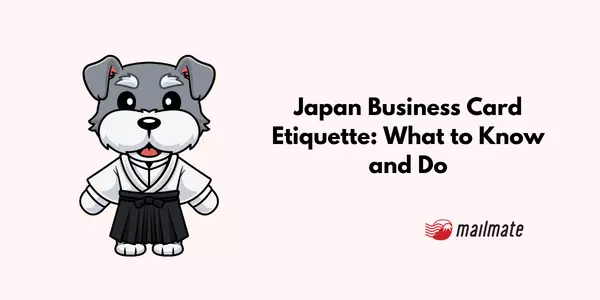Japan Business Card Etiquette: What to Know and Do

Feeling ready to expand your Japanese business etiquette knowledge?
Today, we're covering the secret to better introductions with Japanese clients. Master Japanese business card etiquette, just in time to impress for your next big pitch meeting.
What is meishi koukan?
The meaning of meishi koukan is "business card exchange." Exchanging meishi is an important aspect of greeting clients and networking in Japan.
Knowing how the exchange process works and how to correctly receive the other person's card will help you make a good impression on your first meeting with clients or business associates.
A step-by-step guide to introducing yourself to Japanese clients
When you arrive at a prospective Japanese client's company, how do introductions unfold?
Japanese business protocol dictates that the visiting/sales party initiates greetings, introductions, and business card exchanges—and within the visiting party, the senior executive goes first.
According to Nishide Hiroko, a business management consultant, from her book on Japanese business manners, what follows is the generally accepted protocol to introducing yourself (and your team) to your clients during your first face-to-face meeting.
Example business scenario of a Japanese business card exchange
You (the senior executive) are meeting with a Japanese CEO to present your pitch. An interpreter and a subordinate in your company are accompanying you to the prospective client's company, where the meeting will take place. On the client-side, the Japanese CEO will be joined by 2 subordinates.

Step 1. The person on your team to speak first should be the person the client's company has—up until this moment—had communication with. In your case, perhaps it was your interpreter or assistant who set up the meeting.
Step 2. The interpreter/assistant will introduce you/the senior executive to the Japanese CEO/or the senior executive on the client-side.
Step 3. You/the senior executive will introduce yourself and exchange business cards with the Japanese CEO/senior executive on the client-side.
Step 4. Then you will introduce yourself and exchange business cards with the client's subordinates in order of rank. (See our bonus section below for how to deal with many business cards at one time.)
Step 5. Next, your subordinate will introduce himself, first exchanging business cards with the Japanese CEO/senior executive on the client-side. And then, in consecutive order of rank, your subordinate will exchange business cards with each of the remaining members on the client-side.
Video: At 3:02 in the graphic illustration, the businessmen at the head of both lines are the senior executives, followed by their subordinates in order of rank.
On the flip side, if you are receiving Japanese visitors who are looking to obtain your business, the senior executive on their sales team will introduce themselves first to you (or whoever is the senior executive on your team) with the exchange of business cards and then to your subordinates in consecutive order of rank.
Once you learn this format for introducing yourself in a Japanese business setting, it will feel like second nature, and after going through this once or twice in real life, you will probably not have to think of this step-by-step again.
Occasionally, the business environment will throw a wrench into this established introduction order but knowing the correct protocol will keep those instances to a minimum.
Bonus: How to smoothly receive multiple business cards at once
Exchanging business cards with one individual is relatively straightforward. And we assume you've mastered this move.
But when a business situation forces you to accept multiple business cards from more than one person, things can get complicated. Placing anything on top of a business card is considered disrespectful, so what do you do when you've received one card and yet there are more to come?
When there are many individuals to exchange cards with, you will want to master the following steps:
Step 1. Accept the first person's card, receiving it on the top of your business card holder momentarily, saying chyoudai itashimasu and bowing respectfully, pausing a little before moving to the next person (don't rush!).
Step 2. As you move to the next person to be introduced, place the first person's business card behind your business card holder, making room to receive Person 2's business card respectfully.
Video: Start at 4:27 to see a visual of how this unfolds.
Step 3. Accept Person 2's business card, receiving it on the top of your business card holder momentarily, saying chyoudai itashimasu and bowing respectfully before moving to the next person.
Step 4. As you move to the next person to be introduced, place Person 2's business card behind Person 1's business card (behind your business card holder), making room to receive Person 3's business card respectfully.
Step 5. Accept Person 3's business card, receiving it on the top of your business card holder momentarily, saying chyoudai itashimasu and bowing respectfully before moving to the next person.
Step 6. Place Person 3's business card behind Person 2's business card (behind your business card holder).
Step 7. Deftly bring the stack of business cards that were behind your business card holder back to rest—once again—on the top of your business card holder—revealing Person 1's business card at the top of the stack of business cards. (Person 1 = the senior executive.)
Step 8. At this point, you will likely take seats. If there is a conference table, you can place the business cards on the table in front of you, mirroring the clients' seating order, with Person 1's card (senior executive) resting on your business card holder.
Placing Japanese business cards that you have received on the table in front of you is standard for business meetings in Japan; it allows you to refer to the cards to avoid forgetting names.
However, if you aren't sure about seniority, even after introductions, seating protocol might clue you in, which we will get to in an upcoming article. If the rank is still unclear, then place each card on the table in front of you, without resting any single card on top of your business card holder.
👉 See also "Working with Japanese Colleagues: 5 Cultural Insights."
In closing
If Japanese business culture feels confusing to you, just remember you are not alone in that feeling.
As we published in an article previously, approx. 40.4% of the Japanese respondents were not so confident in their business etiquette, and 9.8% said they were not confident at all.

We hope it's somewhat comforting to know that even Japanese have trouble with Japanese business manners.
Need help with making the right impression on potential customers? Sign up to MailMate and get exclusive access to a bilingual concierge service!
Spending too long figuring out your Japanese mail?
Virtual mail + translation services start at 3800 per month. 30-day money-back guarantee.

